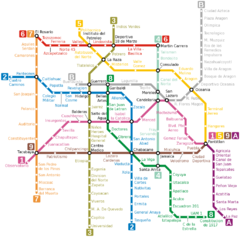Most of the systems that you mentioned are US systems. Their overall impact is very small. They're worthless to be precise-precisely because they are so tiny. Other systems are just small... like edmonton... it just mimics a subway line.
You mention mexico city - what a joke! That city has one of the bigger metro systems in the world. Just look at the beauty,
A system which was first opened more than a decade after toronto's has fares that are roughly 10 times cheaper, and in total the system is more than three times bigger than toronto's.
This is the point, these places are not worried to finance these vital things.
Lets look at the stuff on your list...
st louis... 13 km light rail...
minnesota... 19 km light rail...
houston... 12 km light rail...
san jose... 68 km, because it's quite large, but total ridership is only 37,536 per day... so sad
buffalo... 10 km light rail...
I mean wtf is this crap? Seriously man, what crap is this?
Why on earth compare second rate - er no, lets say 4th rate - systems when you can look at some truly good systems in europe and asia? Your list is a bunch of miserable systems that a disgrace, that most surely should not be a model for the future of any big major city. The europeans and asians would laugh at this, and with good reason.
The airport is getting a heavy rail connection: Union Pearson Air Rail Link. Again, feel free to debate semantics.
I mean underground heavy rail. Good cities have their metro system connecting to the airport. Chicago has two metro lines going to two airports. Vancouver has one.
From what I know, toronto's plan is to put a go line to the metro, instead of a subway line. I would rather pay the 2.75 or what is it than to pay big money to go to downtown. Further, why the hell do you assume that people want to go downtown when they first get to town? People should have the choice to go where they want. They get off the airport, go on the englinton cross town subway... transfer up north up young and voila... oh wait, yeah, I gotta stop dreaming.
It will be tunnelled under Eglinton. That makes it a subway in my opinion.
Subway assumes heavy rail mass transit. I use metro and subway interchangeably. Perhaps if I said metro from now on... perhaps that would would make more sense.
Sheppard LRT: $63 million per km. Spadina Subway is $302 million per km. Even if you cut that in half, you're still more than double the LRT cost.
The benefits would be even greater.
As for the costs - I really think that they are ridiculous, if that is true.
However, we gotta think about the future... if we want to have a truly rock-star city we will need to invest a lot into lines to get people quickly from one part of town to the other. Metro is going to do this, not light rail.
Toronto can do better. But we're a bankrupt country when it all boils down. A country which took the wrong steps by being too similar to the rotting USA, instead of being more like efficient Europe and Asia. I see that we are falling behind.











